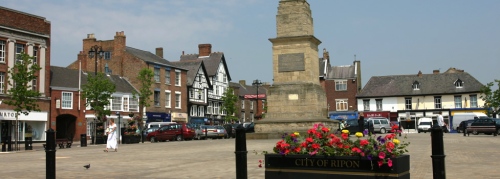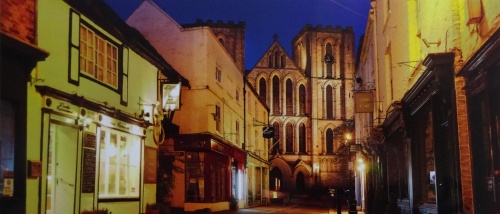I’m off to Oban on the West Coast of Scotland to visit friends who have moved there to live: I have not seen them for over a year and the trip which was planned earlier in 2016 did not work out because of accidents to, and sudden and severe problems with, one of my knees. It should take about nine hours to drive there barring severe traffic, bad weather, road diversions or road works. But in UK most of these will occur so I am not expecting a hugely fast trip and anyway it will be more fun to take my time and see things that I want to see. One thing I have learned this year is that we must take every opportunity to do things we want to do, never put it off!!
So . . . . . . . . . . . . . . .
Dates worked out with friends’ timetable: tick.
Places I wish to visit en route: tick. (Ripon, Carlisle, Birdoswald Roman Fort, Loch Lomond, Oban, Killin, Stirling, Falkirk, the Antonine Wall, Hexham, Corbridge Roman Town, Middleham Castle, Richmond Castle.)
Route planned: tick. (Must include the A66 and the A68!)
(A few notes about my route. I am basically travelling North up the West, and back South down the East, sides of the country, although I am not heading to the Western route immediately.
From home I am taking the A1 from here northwards to Scotch Corner. The A1 used to be called the Great North Road as it was the highway from London to Edinburgh. It has been superceded to some extent by the newer M1, the first motorway built in this country, but I suffer travelling the first part of the M1 northwards from here to Leeds as PTSD makes the journey distressing, both mentally and physically (some terrible things happened to me in Leeds many years ago) and anyway I prefer the A1. Since becoming more of a secondary route it is not usually so busy, fast or intense as the M1. Scotch Corner is so called because it is the point of divergence for northbound traffic which splits here to head either West to Glasgow [on the A66] or continuing to Edinburgh. From Scotch Corner I shall take the A66 which is a lovely road over to the West through Cumbria and there stop over in Carlisle, thereafter joining the M6 leading North to the M8 taking me round Glasgow to Loch Lomond [another stop there] and then up the side of the Loch on the A82 to Crianlarich and on to Tyndrum, from where I shall cross West to Oban on the A85.
On my way home I shall cross Scotland from Oban to Stirling via a stop for lunch at Killin, coming back along the A85 and turning off at Lochearnhead on to the A84 and M90. Then continuing on down to visit Stirling Castle and Falkirk [another stop here], M9 and A720 round Edinburgh and travel South on the A68 through Northumbria which is a road I love and which holds many happy memories, to Hexham [a stopover here too]. Thence continuing on the A68 all the way back to the A1 near Darlington, this time Southbound, Richmond and home.
Daily mileage worked out: tick.
B&B research re budget price, accessibility, ground floor rooms and walk-in showers: tick.
B&Bs booked: tick.
Plants planted: plants watered: animal food bought: husband food bought: lists of instructions for husband written: vet’s instructions for dog and gecko written out and medication timetabled: an evening out with each of two of the three grandchildren achieved: medications gathered in: physical aids gathered in: maps sorted:
Gosh, will I ever get off?
Yes, its Sunday lunchtime, I’m ready and I’m leaving.
First stop, Ripon in Yorkshire. I want to see the Cathedral and especially the Crypt. Apparently it is only an hour’s drive away from my home, according to Google.
I hit the motorway, sun shining, easy listening – Vivaldi’s Concerto for Flute and Oboe on the Radio. Freedom. I feel eighteen years old.
Ring husband – “Did I forget to collect my Magnesium oil from the kitchen worktop?” (In this new car you can phone using the car itself, hand free, magic!!!)
“Cannot see it, you must have picked it up!”
Ring husband – “I forgot to mention the vitamin drops in the Gecko’s water, they are on the bathroom shelf.”
Ring husband – “I think I forgot to water the plants in the conservatory, would you mind giving them a little please. Thanks.”
The traffic gets really bad, no chance to ring again, road works, diversions, everyone slowing down.
It takes me several hours to reach Ripon and I am shattered: from the driving and the leaving home.
The city of Ripon is located in North Yorkshire on the River Ure. Ripon is a beautiful market town that was founded over 1300 years ago, and is famous as an old Cathedral City where monasteries have stood since the 7th Century.
(from http://www.ripon.org)
Find hotel which is in the main square, (the half-timbered building to the left of the obelisk at the rear of the square)

(photo from http://greatnorthartshow.co.uk)
check in for their really cheap Sunday night special, park car, have bar snack, settle in room, unpack loo seat (from its three bags which are meant to camouflage its existence) and fall into bed by 8.0 pm and sleep.
Nine p.m. Oh really, this is too much, I had forgotten all about the hornblower. He blows his horn each night at nine in the evening, once at each corner of the square. Four times!!!
The following article is taken from the BBC in 2014,

Ripon hornblower, George Pickles
Ripon’s hornblower
By George Pickles
The watch has been set in Ripon every single night for well over one thousand years. The ceremony is one of the oldest still performed in England. George Pickles is the current hornblower and tells the story of this ancient ceremony.
The setting of the watch dates back more than 1100 years to the year 886. That was Saxon times, and also troubled times. The Vikings were raiding up and down the east coast and occupying parts of the country. The local thieves, rogues and vagabonds were taking advantage of the unsettled situation.
On the English throne at that time was King Alfred the Great. He had lost his father and three elder brothers fighting the Vikings, but he was intent on victory and bringing stability back to the country. In 886, at the age of 37, he recaptured London from the intruders and set about touring the country drumming up support and giving confidence back to the people.
 The original horn given to Ripon in 886
The original horn given to Ripon in 886
When he arrived in Ripon, he liked what he saw and decided to grant a Royal Charter to the settlement, which is all it was at the time. The only thing he had to offer the people as a symbol of that charter in those simple times was a horn.
On the advice of the King it was decided that the people of Ripon should become more vigilant and should always be alert to the danger around them. They could lose their settlement and the relatively good way of life they were enjoying, should an unexpected enemy descend upon them.
 The Hornblower sets the watch
The Hornblower sets the watch
It was therefore decided to appoint a wakeman. That was a man who would stay awake and patrol the settlement and the surrounding areas from dusk till dawn. He kept a watchful eye for any approaching enemy or troublemakers, while the rest of the people slept safely in their beds. It was further decided that the wakemen should put the charter horn to good use. He would sound it at the four corners of the market cross each evening at 9pm to let the people know that the watch was set and he was now on patrol.
Because the first wakeman of the day needed to be paid for his work it was decided to impose a tax on the citizens. After much debate it was decided they would be levied according to the position of their house door. If your door faced onto the market square, or a main thoroughfare of the city you were considered to be well off and were charged four pence per door, per year tax. If your door was down the side or round the back you were considered to be less well off and you were only charged one penny per door each year.
“If your door was down the side or round the back you were considered to be less well off and you were only charged one penny per door each year.”
George Pickles
It is still evident today that homes built after this tax was introduced were designed in a way that the position of the door brought them into the lower tax bracket. They were built with a very narrow frontage and most had a ginnell down the side leading to the door. There is still evidence if you look at the oldest properties in the city.
This system prevailed until 1604, when a second charter was granted to the city by James I of England, who was James VI of Scotland, and was the first king to reign over a united Britain. It was decided that the time had come to make things more democratic in Ripon. The wakeman of the day had become a very powerful man and was elected or re-elected annually by 15 of his peers, these being the most influential men in the city. These men were the city’s ‘police force’ and ruled the city with a rod of iron.
That year a mayor was elected democratically for the first time by vote, by all the people. The first mayor of 1604 was Mr Hugh Ripley who happened to be the last Wakeman of 1603. He lived in the house which still stands at the south west corner of the market square. Wishing to keep the setting of the watch ceremony alive, the mayor appointed a hornblower to carry out the duty of sounding the horn at the four corners of the market cross each evening on his behalf.
Because he didn’t trust him, and to ensure that the hornblower fulfilled his obligations, he imposed an extra duty on him. After setting the watch at the market cross, he must find the mayor of the day, wherever he may be in the city and sound the horn three times in front of him, raise his hat, bow his head and say the words “Mr Mayor, the watch is set”. This is to prove his duty has been done.
That ritual is still carried out at nine o’clock every night at the Obelisk and has not been missed, not for one night, in over 1100 years.
George Pickles
How on earth could I have forgotten about this. But to be fair, it is not something I have given a moment’s thought to for over 40 years. Back to sleep, too tired to stay awake any longer. Lovely high bed, comfy mattress, no responsibilities except for myself.
Ahhhhhhhhhhhhhhhhhh:)

View of Ripon Cathedral at night.
